8 Critical Signs You Need a New Roof in 2025
By Sunrise Roofers LLC · Oct 20, 2025 · 15-23 min read
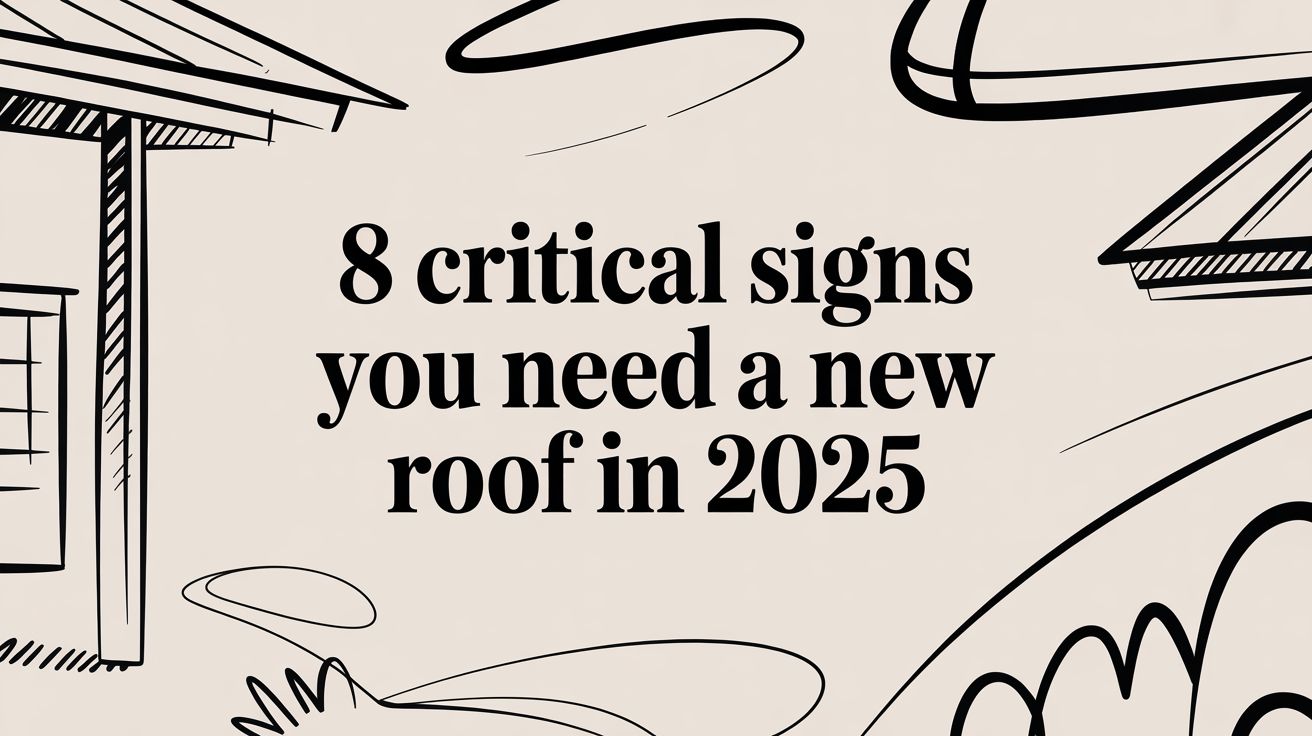
Your roof is your home's primary shield against Tucson's intense sun and monsoon downpours, but this vital defense weakens over time. Ignoring the early warnings can lead to catastrophic failures, turning a manageable replacement into an emergency crisis involving interior water damage, mold, and structural risks. Many homeowners postpone this critical investment, unsure if minor repairs are sufficient or if a full replacement is truly necessary.
This guide is designed to cut through that uncertainty. We will detail the eight definitive signs you need a new roof, providing actionable, Tucson-specific insights to help you assess your situation with confidence. Understanding these clear indicators, from visible shingle deterioration and granule loss to hidden attic warnings and structural sagging, allows you to act before small problems become expensive disasters.
Instead of guessing, you'll learn exactly what to look for on your roof, in your attic, and inside your home. By recognizing these key signals, you can proactively protect your property's value, ensure your family's safety, and make an informed decision about one of your most important assets. Before the next monsoon season arrives, let’s determine if your roof is still up to the task.
1. Widespread Shingle Damage: The Most Obvious Red Flag
Your roof's shingles are its first line of defense, but in Tucson, the relentless sun acts as a constant adversary. Intense UV exposure bakes the essential oils out of asphalt shingles, causing them to lose flexibility and become brittle. This accelerated aging process is one of the most visible signs you need a new roof.
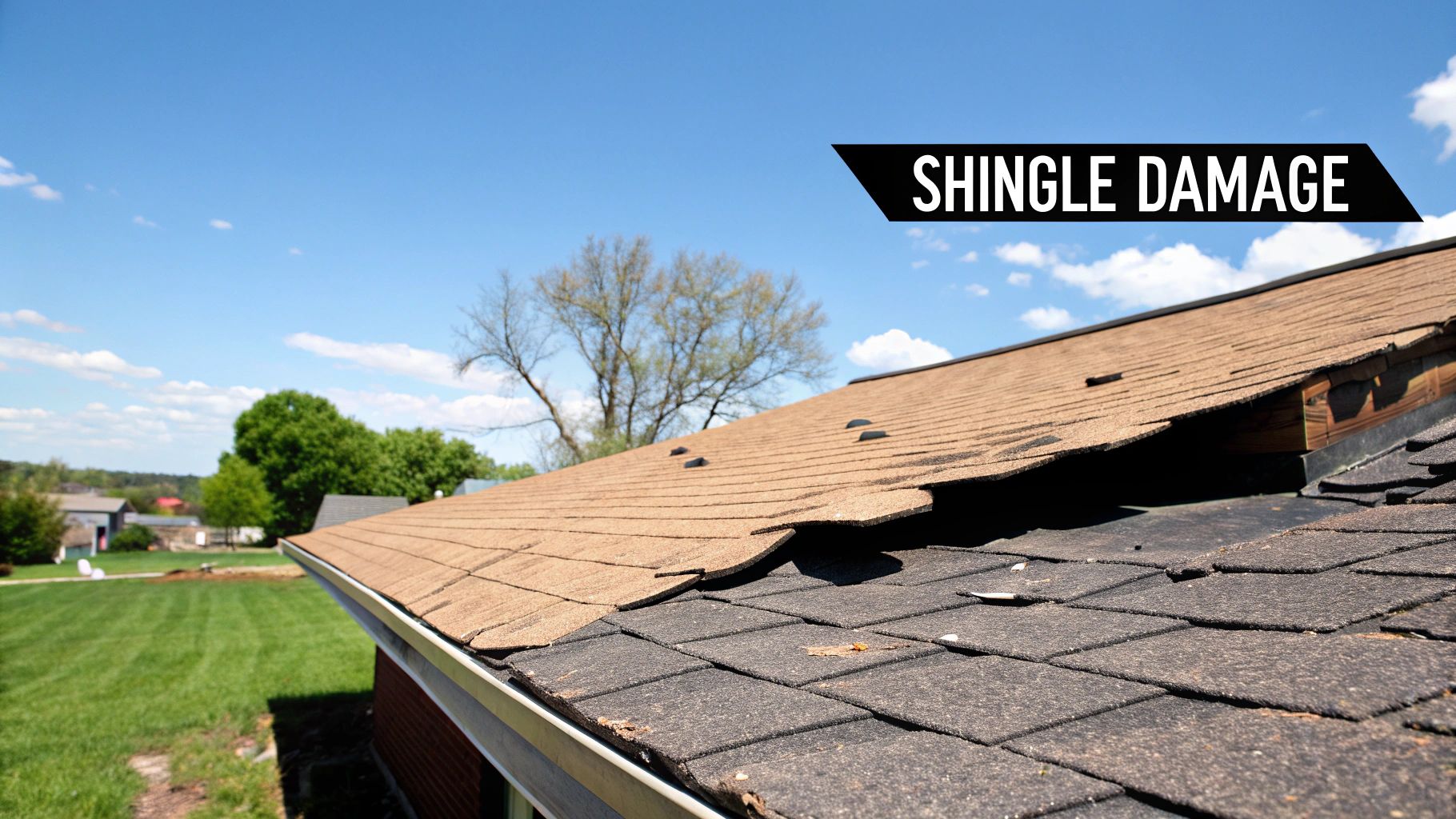
When shingles are compromised, they can no longer create a waterproof barrier to protect your home. While a single damaged shingle might be an isolated issue, widespread, systemic failure across multiple roof sections indicates the entire system is nearing the end of its life.
What to Look For
Here are the specific types of shingle damage that signal a problem:
- Curling and Cupping: Shingles whose edges are either turning upward (curling) or buckling in the middle (cupping) are no longer lying flat. This creates entry points for wind and water.
- Cracking and Splitting: Thermal shock from Tucson’s dramatic temperature swings can cause older, brittle shingles to develop cracks, leaving the underlying roof deck vulnerable.
- Widespread Granule Loss: Check your gutters and downspouts for an excessive accumulation of "roof sand." These granules protect the shingle from UV rays; when they're gone, the shingle deteriorates rapidly.
Actionable Inspection Tips
A small problem can become a major expense if ignored. Use these tips to safely assess your shingles:
- Ground-Level Check: Use a pair of binoculars to get a safe, detailed look at your roof from the ground. Focus on the areas that get the most direct sun.
- Post-Storm Walkaround: After a significant monsoon storm, walk the perimeter of your property to check for any shingles that may have been blown off.
- Professional Assessment: Systemic damage requires an expert eye. A professional inspection can determine if a few repairs will suffice or if the wiser investment is a full replacement. Sunrise Roofers provides detailed, photo-documented inspections to give you a clear and honest picture of your roof's condition.
If you're noticing these issues, it's a strong indicator that your roof's integrity is compromised. Explore our solutions for shingle roof replacement in Tucson to see how we can restore your home's protection.
2. Roof Age Exceeding Life Expectancy
While physical damage is a clear warning, one of the most reliable signs you need a new roof is simply its age. Every roofing material has a finite lifespan, and in Tucson's harsh climate, that clock ticks a little faster. Even a roof that looks decent from the ground can be on the verge of failure once it surpasses its manufacturer-rated service life.
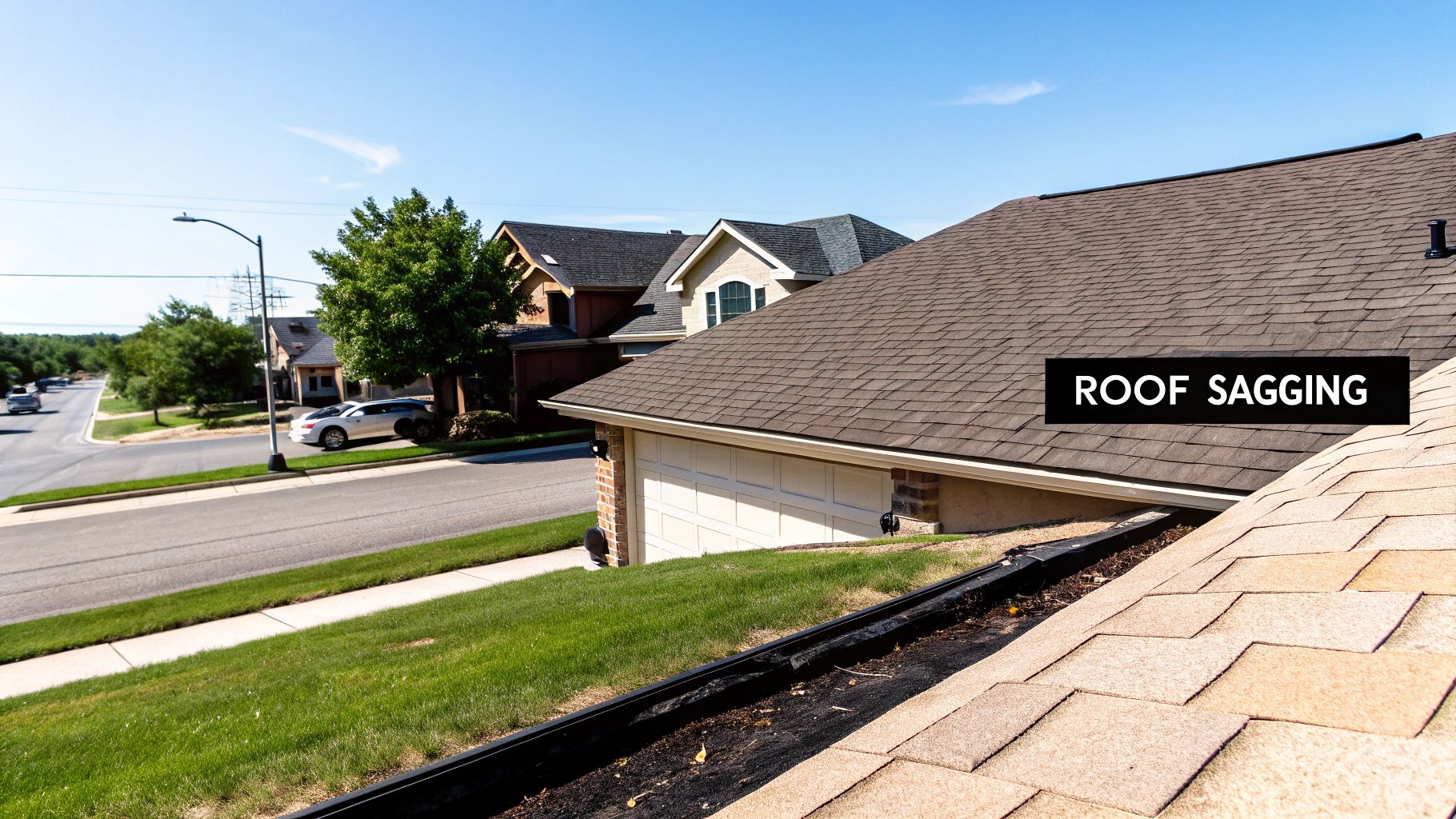
As roofing materials age, they degrade from cumulative exposure to UV radiation, thermal shock, and monsoon storms. The protective layers wear thin, seals become brittle, and the entire system loses its ability to flex and resist damage. Proactively replacing an old roof is often a wiser financial decision than waiting for a catastrophic failure and the costly interior water damage that follows.
What to Look For
Different materials have different timelines. Here’s a general guide for Southern Arizona:
- Asphalt Shingles: Most standard shingles in our climate last between 15 and 25 years. If your home was built in the late 1990s or early 2000s and still has its original roof, it's likely due for replacement.
- Tile and Metal Roofs: These are known for their longevity, often lasting 50 years or more. However, the underlayment beneath them is not permanent and typically requires replacement every 20 to 30 years.
- Flat Roofs (Modified Bitumen/TPO): These systems commonly found in Tucson have a lifespan of 15 to 25 years, depending heavily on the material and quality of installation.
Actionable Inspection Tips
Determining your roof's age is a critical first step in planning for its future.
- Check Your Records: Review your home inspection report from when you purchased the property or look for building permits filed with the city. These documents often state the last installation date.
- Ask Previous Owners: If possible, contact the previous homeowners. They may have records or recall when the roof was last replaced.
- Schedule a Professional Inspection: If your roof is approaching the 15-year mark, it’s time for an expert assessment. A professional can identify age-related weaknesses that aren't visible from the ground and give you a realistic estimate of its remaining life. Sunrise Roofers can help you understand your roof's history and plan for the future.
If your roof is past its prime, don't wait for a leak to tell you it's time for a change. Find out more about our comprehensive roof replacement services in Tucson to ensure your home remains protected.
3. Sagging or Structural Deformation
A sagging roof is more than a cosmetic flaw; it's a critical warning of deep structural problems that require immediate attention. This alarming issue occurs when the roof deck, rafters, or support trusses are compromised, often due to prolonged water damage, excessive weight, or simply age-related deterioration. A sagging roofline, which may appear as a noticeable dip, wave, or droop, is one of the most serious signs you need a new roof because it signals a potential failure of the entire system.
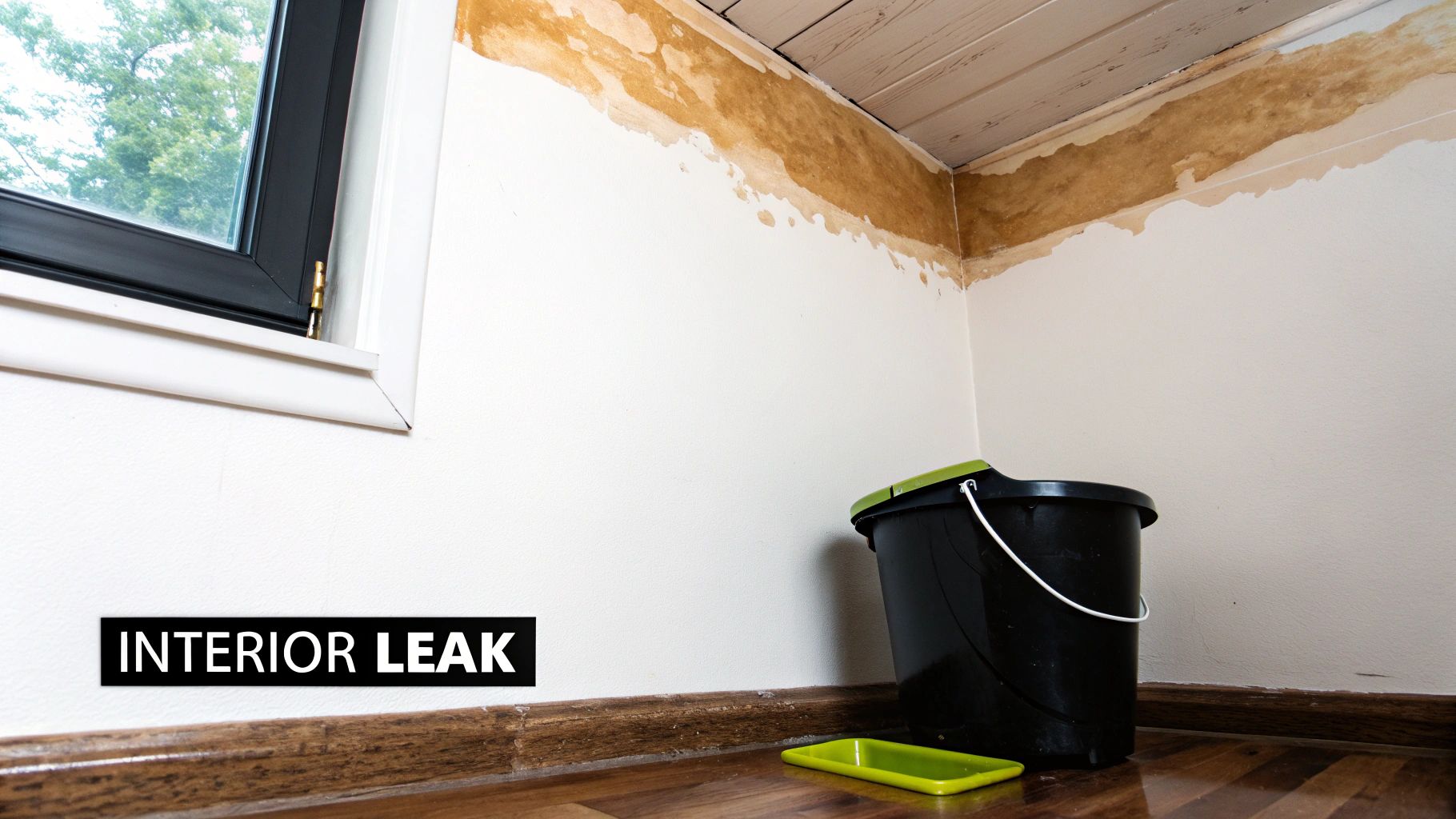
Unlike isolated shingle damage, a sagging roof points to a problem with the foundational framework holding everything up. Ignoring this can lead to catastrophic collapse, posing a significant safety risk to your property and everyone inside. This is not a "wait and see" problem; it's a structural emergency.
What to Look For
Here are the specific indicators of structural deformation:
- Visible Dips or "Saddles": Look at your roofline from across the street. A sagging roof will have a noticeable curve or dip in the ridgeline, similar to the back of a horse.
- Spongy or Bouncy Feel: If you are safely on the roof, a soft or spongy feeling underfoot indicates that the underlying decking is rotted and has lost its structural integrity.
- Interior Signs: Check your attic for cracked or strained rafters, water stains on the underside of the roof deck, or daylight showing through where it shouldn't be.
Actionable Inspection Tips
Identifying structural issues early is key to preventing a complete roof failure. Use these tips for a safe and effective assessment:
- View From a Distance: Regularly view your roofline from multiple angles on the ground. This makes it easier to spot developing sags that might be subtle up close.
- Attic Inspection: Safely enter your attic with a bright flashlight and look for signs of moisture, rot, or compromised wood trusses. A straight edge can help detect subtle sagging in the decking from below.
- Professional Structural Assessment: Never attempt a DIY fix on a sagging roof. This issue requires a professional evaluation from a qualified roofer or structural engineer to determine the cause and the safest course of action. Sunrise Roofers can assess the root cause and provide a comprehensive plan for repair or full replacement.
If you notice any sagging, it’s imperative to act quickly. Learn more about our approach to complex structural issues and roof replacement in Tucson to ensure your home is safe and secure.
4. Water Damage and Interior Leaks
Water infiltration is one of the most critical and potentially costly consequences of a failing roof. When you see signs of moisture inside your home, such as water stains on the ceiling, peeling paint, or active dripping, it's a clear indication that your roof's protective barrier has been breached. These are not just cosmetic issues; they are urgent signs you need a new roof.
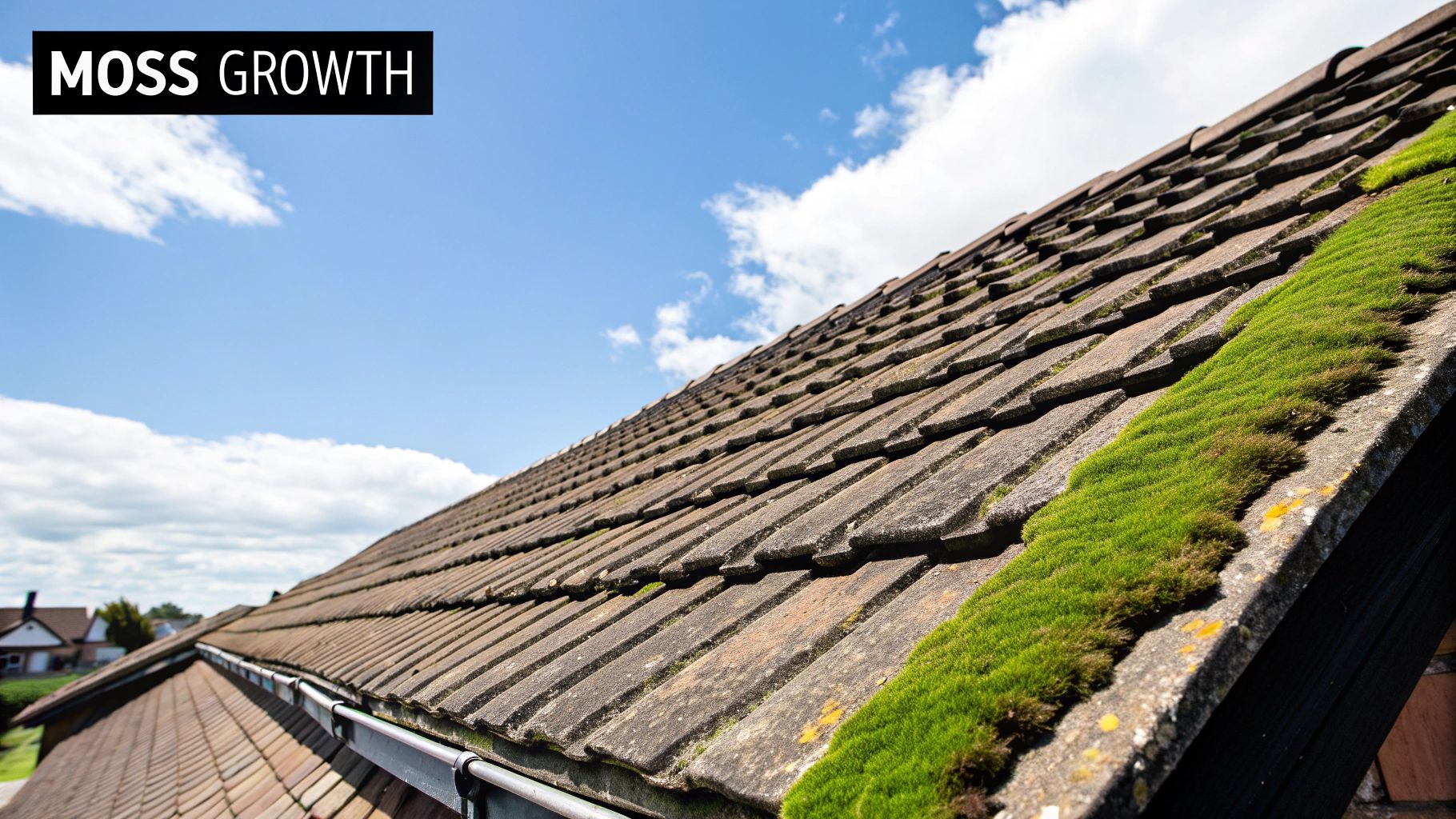
While an isolated leak might point to a specific repair, chronic moisture problems or multiple leak points suggest systemic failure. Over time, even a small, slow leak can saturate insulation, rot structural wood, and create an ideal environment for dangerous mold growth. Ignoring these warnings can lead to thousands of dollars in hidden damages beyond the roof itself.
What to Look For
Interior water damage can appear in several forms. Be vigilant for these common indicators:
- Discoloration and Stains: Look for brownish or yellowish rings on ceilings or running down walls. These are tell-tale signs of a slow, persistent leak.
- Peeling or Bubbling Paint: Moisture getting trapped behind drywall or plaster will cause the paint to bubble, blister, or peel away from the surface.
- Musty Odors and Mold: A persistent damp or musty smell, especially in your attic or upper-floor closets, often points to hidden moisture and potential mold growth.
Actionable Inspection Tips
Never ignore signs of a leak. Quick action can mitigate the damage while you determine the source.
- Contain the Damage: As soon as you spot an active leak, place buckets to catch dripping water and move any valuable furniture or electronics out of the area.
- Check the Attic: If it's safe to do so, check your attic during or immediately after a rainstorm. You may be able to trace the water's path back to the entry point on the roof deck.
- Professional Assessment: Widespread or recurring leaks demand an expert diagnosis. A thorough evaluation can pinpoint the source of failure and determine if a full replacement is necessary to protect your home. Schedule a professional roof inspection in Tucson to understand the full extent of the problem and prevent further costly damage.
If you are seeing any of these interior signs, your roof is actively failing to protect your home. Addressing the root cause with a roof replacement is the most effective way to secure your property.
5. Excessive Granule Loss: Your Roof’s Sunscreen is Washing Away
Asphalt shingles are covered in a layer of crushed, ceramic-coated mineral granules. This coating isn't just for color; it's a critical shield that protects the underlying asphalt from the sun's harsh UV rays, which is especially important in Tucson's climate. While gradual granule loss is normal over a roof's lifespan, a sudden increase is one of the clearest signs you need a new roof.
When this protective layer wears away, the shingle's asphalt core is exposed directly to the elements. UV radiation breaks down the asphalt, making it brittle and prone to cracking. This accelerated deterioration severely shortens the roof's lifespan and leaves your home vulnerable to leaks and further damage.
What to Look For
Here are the tell-tale indicators of excessive granule loss:
- Granule Buildup in Gutters: Finding cups of "roof sand" in your gutters or at the bottom of downspouts during seasonal cleaning is the most common sign.
- Bald or Dark Patches: From the ground, you may notice shingles that look inconsistent in color or have dark, "bald" spots where the black asphalt is showing through.
- Accelerated Runoff: You might see granules washing out in a visible stream from your downspouts during a monsoon rainstorm.
Actionable Inspection Tips
Tracking granule loss can help you anticipate the need for a replacement before major problems arise. Use these tips for a proper assessment:
- Check Gutters Seasonally: Clean your gutters regularly and take note of the amount of granules you find. A handful or more per cleaning session suggests advanced wear.
- Track Progression: Compare the amount of granules you find each time you clean the gutters. A noticeable increase signals that your roof's deterioration is speeding up.
- The "White Glove" Test: Carefully and safely run a hand over a shingle. If a significant amount of granules comes off on your hand, the shingle's bond is weakening.
- Photograph Bare Spots: Take pictures of any bald patches to monitor if they are growing larger over time, indicating a systemic failure.
If your gutters are consistently full of granules and you see visible bare spots, your roof's primary defense system has failed. Contact Sunrise Roofers for a professional evaluation to determine the extent of the damage and discuss your options for a durable roof replacement in Tucson.
6. Daylight Visible Through Roof Boards
Seeing daylight stream into your attic is more than just an eerie sight; it's an undeniable sign of a critical roof failure. This indicates a complete breach in your home's protective envelope, where shingles have failed, roof decking has separated, or holes have formed. This is one of the most urgent signs you need a new roof because if light can get in, so can water, pests, and the intense Tucson heat.
Unlike subtle granule loss or minor curling, visible daylight points to a fundamental breakdown in the roof's structure. These gaps are direct invitations for monsoon rains to cause catastrophic water damage and for desert critters to make a home in your attic. This level of compromise almost always necessitates a full roof replacement.
What to Look For
Pinpointing light sources in your attic requires a careful and methodical approach:
- Pinpricks of Light: Small, scattered points of light often indicate that nails have backed out or that shingles have deteriorated to the point of being porous.
- Gaps Along Seams: Light visible along the seams where sheets of roof decking meet can signal that the wood has warped or shifted due to moisture damage.
- Larger, Obvious Holes: These are the most severe issues, often caused by storm damage, rot, or animal activity where pests have chewed through the roof materials.
Actionable Inspection Tips
A thorough attic inspection is the best way to confirm this serious roofing problem. Use these tips for a safe and effective assessment:
- Choose a Bright Day: Conduct your inspection on a sunny day. The stark contrast between the dark attic and the bright exterior light will make any breach easy to spot.
- Turn Off the Lights: Once safely in the attic, turn off all lights and let your eyes adjust for several minutes to see even the smallest light sources.
- Mark and Document: Use chalk or brightly colored tape to mark every spot where you see light. Take clear photos of these areas for your records and for sharing with a roofing professional.
If you discover daylight in your attic, immediate action is crucial. Understanding what to look for is a key part of any property evaluation, a topic we cover in our Tucson homebuyer roof inspection checklist. Contact Sunrise Roofers right away for an emergency assessment to prevent further damage.
7. Moss, Algae, and Organic Growth
While less common in Tucson's arid climate, organic growth on your roof is a serious issue that should never be ignored. Moss, algae, and lichens thrive in shaded, damp areas, and their presence indicates that your roofing materials are retaining moisture, a critical problem that accelerates deterioration.
This trapped moisture can lead to rot in the underlying roof deck and compromise the structural integrity of your home. What may seem like a cosmetic nuisance is often one of the more subtle but damaging signs you need a new roof, as it points to systemic moisture issues that cleaning alone cannot fix.
What to Look For
Different types of growth cause unique problems, all of which compromise your roof's ability to protect your home:
- Moss: This green, fuzzy growth acts like a sponge, holding water against your shingles. Its root-like structures can dig under shingle edges, lifting them and creating pathways for water to seep underneath.
- Algae (Gloeocapsa magma): This appears as dark, ugly black streaks on your roof. While it doesn't have roots, it feeds on the limestone filler in asphalt shingles, slowly eating away at the protective granules and weakening the shingle over time.
- Lichens: A combination of algae and fungus, lichens have strong roots that can penetrate and dislodge the protective granules on shingles, leading to premature aging and failure.
Actionable Inspection Tips
Addressing organic growth requires careful evaluation to avoid causing more damage than the growth itself:
- Identify Problem Areas: Focus your inspection on the north-facing side of your roof and any areas shaded by large trees, as these spots receive less sunlight and are more prone to moisture.
- Assess the Extent: If growth covers more than 25% of the roof surface or the moss is thick enough to lift easily in sheets, it often indicates the underlying materials are too compromised for a simple cleaning.
- Never Power Wash: Aggressive cleaning methods like power washing can strip away shingle granules and severely shorten your roof's lifespan. If growth is minimal, consider a professional soft-wash treatment.
For flat roofs experiencing ponding water that encourages organic growth, a professional coating can be a powerful solution. Explore how a flat roof coating in Tucson can create a seamless, waterproof barrier to prevent these issues.
8. Damaged or Deteriorated Flashing
Flashing is the thin metal stripping that directs water away from your roof's most vulnerable points, such as chimneys, vents, skylights, and valleys. In Tucson, the intense sun and thermal shock can cause these metal components to warp, corrode, or pull away from the roof structure, compromising their water-shedding capabilities. This damage is one of the more subtle yet critical signs you need a new roof.
While a single piece of failing flashing might be repairable, widespread deterioration across multiple points indicates a systemic problem. Since flashing is integral to the entire roofing system, attempting piecemeal fixes on an old roof is often a temporary solution to a permanent problem, leading to hidden leaks and costly water damage.
What to Look For
Focus on the intersections and protrusions on your roof, as these are the primary locations for flashing failure:
- Corrosion and Rust: Visible rust spots or corrosion on metal flashing, especially in roof valleys, signal that the material is breaking down and can no longer create a waterproof seal.
- Gaps and Separation: Look for flashing that has pulled away from chimneys, walls, or skylights. These gaps create a direct path for rainwater to enter your home.
- Cracked Sealants: Hardened, cracked, or crumbling sealant (like tar or caulk) around flashing is a clear sign that the original seal has failed and is no longer protecting the joint.
Actionable Inspection Tips
Inspecting flashing is key to catching leaks before they cause major damage. Use these tips for a safe and effective assessment:
- Binocular Inspection: From the ground, use binoculars to get a close-up view of the flashing around your chimney, vents, and skylights without having to get on the roof.
- Attic Check: After a rainstorm, safely check your attic space. Look for water stains or damp insulation on the underside of the roof deck, particularly below chimneys and vents.
- Professional Diagnosis: System-wide flashing failure requires an expert evaluation. A professional can identify if spot repairs are sufficient or if a full replacement is the more durable and cost-effective solution. Sunrise Roofers can assess these critical points and determine the best course of action.
If you suspect flashing is the culprit behind your roofing issues, it’s important to act quickly. Learn more about how we handle these critical issues through our roof repair services in Tucson.
8 Key Signs You Need a New Roof Comparison
| Indicator | Implementation Complexity 🔄 | Resource Requirements ⚡ | Expected Outcomes 📊 | Ideal Use Cases 💡 | Key Advantages ⭐ |
|---|---|---|---|---|---|
| Shingle Damage and Deterioration | Low - visual inspection, basic repairs | Moderate - occasional repairs or replacement | Prevents leaks; indicates aging; may need replacement soon | Routine roof checks after storms; aging roofs | Easy to spot; clear age/wear indicator |
| Roof Age Exceeding Life Expectancy | Low - document review, inspections | Low to moderate - inspection, budgeting | Timely proactive replacement; avoids emergency failure | Homes approaching material lifespan | Objective timeline; improves value & planning |
| Sagging or Structural Deformation | High - requires structural engineering | High - structural repair and replacement | Prevents collapse; addresses severe safety issues | Roofs with visible dips, truss damage | Early visible warning; safety-critical |
| Water Damage and Interior Leaks | Moderate - attic and interior inspection | High - roof and interior repairs, mold remediation | Stops further damage; mitigates health risks | Homes with interior stains or known leaks | Clear indication of failure; motivates action |
| Excessive Granule Loss | Low to moderate - gutter cleaning, visual checks | Low - frequent monitoring; replacement when advanced | Signals advanced shingle deterioration | Aging asphalt shingle roofs | Early warning; easy to detect |
| Daylight Visible Through Roof Boards | Moderate - attic inspection required | Moderate to high - immediate repairs | Critical breach identification; prevents pests/infiltration | Roofs with suspected decking gaps | Unambiguous breach detection; motivates fast response |
| Moss, Algae, and Organic Growth | Low - visual inspections and soft washing | Moderate - treatment vs replacement decisions | Controls moisture retention; prolongs roof life if managed | Roofs in humid or shaded environments | Early treatable sign; indicates moisture issues |
| Damaged or Deteriorated Flashing | Moderate - professional inspection needed | Moderate to high - flashing repair/replacement | Prevents leaks at joints; extends roof lifespan | Roofs with leaks near roof penetrations | Localized issues; sometimes repairable |
Your Next Step: From Uncertainty to a Secure Roof
Navigating the complexities of roof health can feel daunting, but recognizing the signs you need a new roof is the most critical first step toward protecting your home. Throughout this guide, we've explored the definitive indicators that your roofing system may be nearing the end of its life, from the subtle evidence of granule loss in your gutters to the unmistakable warning of a sagging roof deck. Each sign, whether it's cracked shingles under the harsh Tucson sun, deteriorated flashing around vents, or persistent leaks after a monsoon storm, tells a piece of a larger story about your roof's integrity.
Understanding these signals moves you from a position of uncertainty to one of empowered awareness. You are now equipped to perform a preliminary visual inspection and identify potential red flags before they escalate into catastrophic failures. Ignoring these warnings, like visible daylight through attic boards or extensive organic growth, doesn't just risk cosmetic damage; it jeopardizes your home's structural stability, indoor air quality, and overall value. The key takeaway is that your roof is a dynamic system, and proactive assessment is your best defense against costly, emergency repairs.
From Diagnosis to Action
While identifying these signs is crucial, the next step involves a professional diagnosis. An experienced, certified roofer can differentiate between an issue requiring a simple, targeted repair and a systemic failure indicating a full replacement is necessary. They bring specialized tools, safety equipment, and an expert eye to assess underlying issues that aren't visible from the ground, such as hidden moisture in the underlayment or compromised decking.
Acting on your observations is not just about fixing a problem; it's about making a strategic investment in your property's future. A new, professionally installed roof offers more than just shelter. It provides:
- Enhanced Protection: Superior defense against Tucson's intense UV radiation and powerful monsoon seasons.
- Improved Energy Efficiency: Modern roofing materials can reflect solar heat, reducing your cooling costs significantly.
- Increased Property Value: A new roof is a major selling point, offering a high return on investment.
- Peace of Mind: Knowing your home and family are protected by a secure, warrantied roofing system is invaluable.
Don't let a small concern today become a major disaster tomorrow. By recognizing these signs and partnering with a trusted professional, you can ensure your home remains a safe, secure, and comfortable sanctuary for years to come.
If you've noticed any of the signs you need a new roof detailed in this guide, our owner-led team at Sunrise Roofers LLC is here to provide a transparent, no-pressure inspection. We'll give you a clear, honest assessment of your roof's condition so you can make an informed decision with confidence. Schedule your free, comprehensive evaluation today by visiting us at Sunrise Roofers LLC.
Article created using Outrank
Need roofing services in Tucson? Request a free inspection or call 520-668-6638. Related pages: Roof Repair · Roof Replacement · Service Areas.
Published by Sunrise Roofers LLC
Licensed & Insured Roofing Contractor · Tucson, AZ